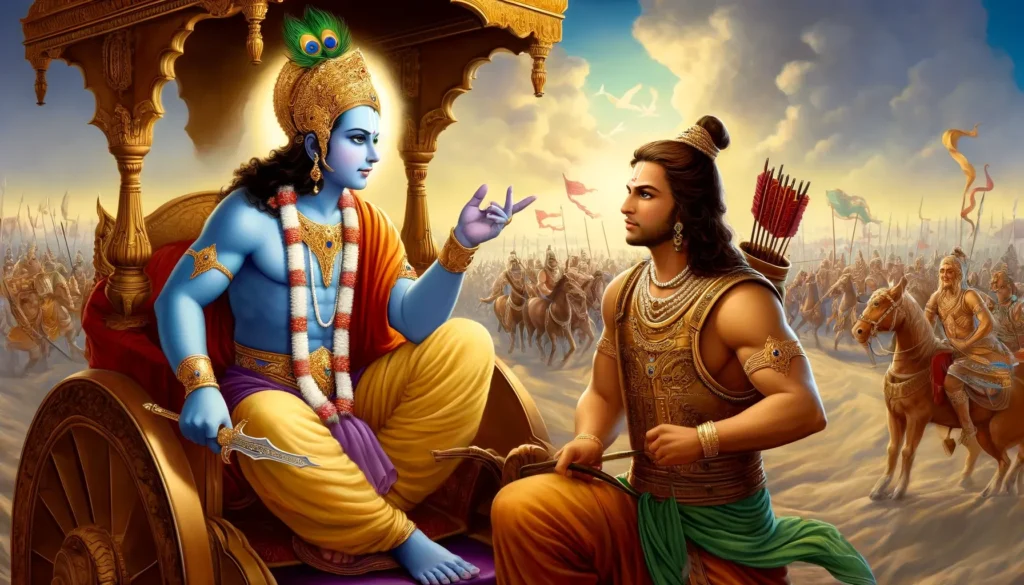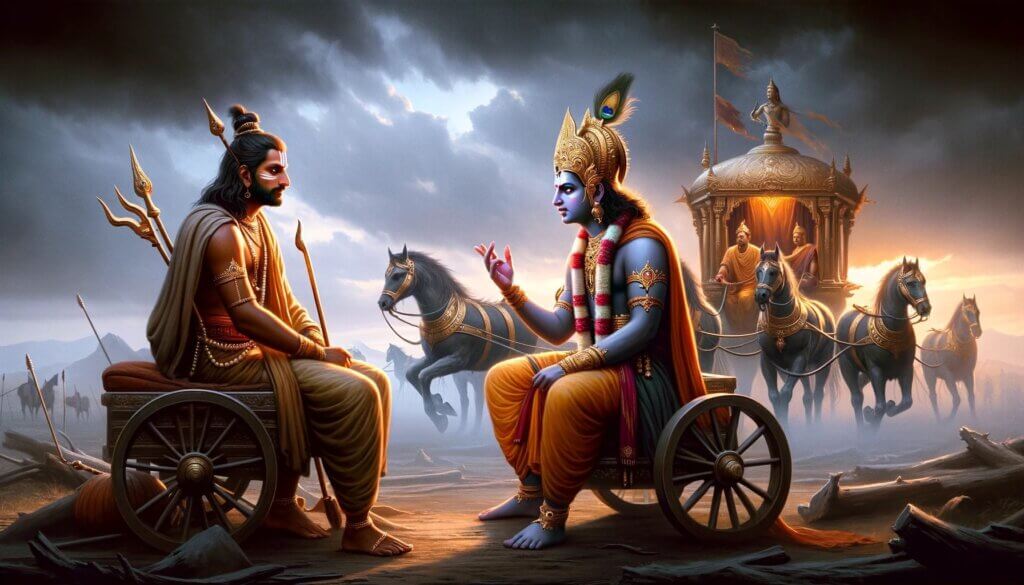The Bhagavad Gita, commonly referred to as the Gita, is one of the most important texts in Hindu philosophy and spirituality. Embedded within the great Indian epic, the Mahabharata, the Bhagavad Gita comprises 700 verses that encapsulate a dialogue between Prince Arjuna and Lord Krishna. This conversation takes place on the battlefield of Kurukshetra, just before a monumental war is about to begin. What unfolds in this discourse is a profound exploration of duty, righteousness, and the path to spiritual liberation. The Bhagavad Gita offers timeless wisdom that has inspired countless individuals across centuries.

The Core Teachings of the Bhagavad Gita
The essence of the Bhagavad Gita lies in its exploration of life’s fundamental questions: What is our duty in this world? How should we approach the challenges and dilemmas we face? How can we achieve true peace and fulfillment? The Gita’s teachings revolve around three main concepts: Dharma (duty/righteousness), Karma (action), and Yoga (the path to spiritual union). These concepts form the foundation of the Gita’s message and are crucial for understanding its relevance.
1. Dharma: The Principle of Righteousness
At the heart of the Bhagavad Gita is the concept of Dharma, or duty. Arjuna, the warrior prince, finds himself in a moral quandary as he prepares to fight in a battle against his own kin. Overwhelmed by doubt and sorrow, he questions the righteousness of his actions. It is in this moment of crisis that Krishna, his charioteer and guide, imparts the wisdom of the Gita. Krishna explains that Arjuna’s duty as a warrior (Kshatriya) is to fight for justice, even if it means battling his own family.
This teaching underscores the importance of performing one’s duty, regardless of personal attachments or emotions. Dharma, in this context, is not merely about following social norms but adhering to a higher cosmic order that sustains the universe.
2. Karma Yoga: The Path of Selfless Action
The Bhagavad Gita introduces the concept of Karma Yoga, or the path of selfless action. Krishna advises Arjuna to engage in his duties without attachment to the outcomes. This principle of non-attachment is a cornerstone of the Gita’s philosophy. By performing actions selflessly, without expecting rewards or fearing consequences, one can attain spiritual growth and inner peace. This teaching is particularly relevant in today’s fast-paced world, where people often find themselves driven by the desire for success and recognition. Karma Yoga encourages individuals to focus on their responsibilities and let go of the obsession with results. This approach not only leads to personal fulfillment but also contributes to the welfare of society as a whole.
3. Bhakti and Jnana Yoga: The Paths of Devotion and Knowledge
In addition to Karma Yoga, the Bhagavad Gita discusses other spiritual paths, such as Bhakti Yoga (the path of devotion) and Jnana Yoga (the path of knowledge). Bhakti Yoga emphasizes the importance of devotion and love for God as a means to achieve spiritual enlightenment. This path encourages surrendering to the divine will and developing a deep, personal connection with the supreme being. Jnana Yoga, on the other hand, focuses on the pursuit of knowledge and wisdom. It involves discerning the true nature of reality and understanding the self’s relationship with the universe. These paths are not mutually exclusive; rather, they complement each other, offering a holistic approach to spiritual development.
4. The Immortal Soul: Understanding the Atman
A central theme in the Bhagavad Gita is the concept of the Atman, or the eternal soul. Krishna teaches that the soul is immortal and indestructible, transcending the physical body and the cycle of birth and death. This understanding of the Atman provides a profound sense of detachment and serenity in the face of life’s inevitable changes. The body is temporary, but the soul is eternal and continues its journey through various lifetimes. This perspective encourages individuals to rise above the material concerns of life and focus on their spiritual evolution.

The Timeless Relevance of the Bhagavad Gita
The teachings of the Bhagavad Gita are as applicable today as they were thousands of years ago. In a world filled with uncertainty, stress, and moral dilemmas, the Gita offers a path to inner peace and clarity. Its emphasis on performing one’s duty without attachment, cultivating devotion, and seeking knowledge provides practical guidance for navigating the complexities of modern life.
Moreover, the Bhagavad Gita’s message transcends religious and cultural boundaries. It speaks to the universal human experience, addressing the challenges we all face in our pursuit of purpose and fulfillment. Whether one is seeking spiritual enlightenment, moral guidance, or simply a deeper understanding of life, the Bhagavad Gita serves as a valuable resource.